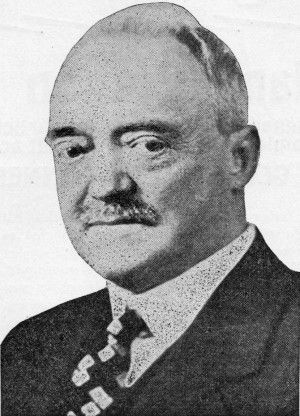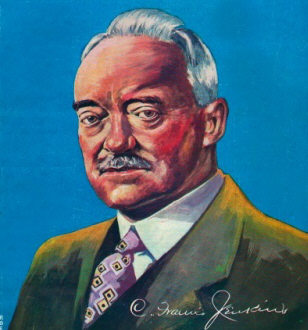Men Who Made Radio - C. Francis Jenkins
|
||
"Father of Radiovision" (RV) was the title bestowed upon Charles Francis Jenkins for his work in what would eventually become known as television (TV), which is a very good thing because otherwise mass confusion would have ensued by now due to the ambiguousness of having to contend with a familiar reference to recreational vehicles (RV) when the "other" RV is what was meant ;-) Mr. Jenkins was also the inventor of the Phantoscope motion picture machine. BTW, did you know that the Coast Guard was originally called "Life-Saving Service?" See other "Men Who Made Radio" : Sir Oliver Lodge, Reginald A. Fessenden, C. Francis Jenkins, Count Georg von Arco, E. F. W. Alexanderson, Frank Conrad, Heinrich Hertz, James Clerk Maxwell Men Who Made Radio - C. Francis Jenkins The Second of a Series
While other great inventors have devoted their attention successfully to the problems of converting sounds into radio waves and back again, or dispersing these waves over the earth and finding them again, the subject of our cover illustration this month has specialized upon a task which differs from all the above. It has been his purpose to extend the range of human sight, rather than of hearing, by radio. And no man has spent more effort, or succeeded so well, in the endeavor to widen the vision of mankind, than C. Francis Jenkins. It was he who by his invention of the "Phantoscope," the parent of all motion-picture machines (the patent rights of which were sold to Thomas A. Edison for the trifle of $2,500) prepared the way for the eighth wonder of the modern world, and made the human race movie-wise, from Alaska to Antarctica. Logically, then, the man who put "motion" into motion pictures may eventually succeed in putting "eye-appeal" into radio - in transforming homes into miniature motion picture theaters! His new 5,000-watt transmitting station in Maryland; his laboratory experiments in the development of radiovision transmitting and receiving apparatus, such as drum scanners and television-image boards; the transmission and reception of weather maps at sea by radio; the sending and receiving of photographs by radio; broadcasting visual images from an airplane; development of a radio or capacity altimeter for landing aircraft; and eventual attempts to broadcast images of living subjects - all of these efforts were designed to make radio's message available to the eye. For this reason, he has been described as the "Father of Radiovision," - just as Dr. de Forest is known as the "Father of Modern Broadcasting." Born 61 years ago in a rural district north of Dayton, Ohio, C. Francis Jenkins, with his Quaker parents, moved to a farm near Richmond, Indiana, where he spent his boyhood. He attended a rural school, a high school, and Earlham College - and, quite recently, he flew from Washington to Indiana in his own air-plane to receive an honorary degree from his alma mater, in recognition of his inventive accomplishments. His youthful days on the farm were marked by their curiosity as to the "innards" of a watch, the workings of farm machinery, and other things mechanical. Affected with wanderlust, he migrated to the wheat-fields and timber regions of the Northwest and, subsequently, to mining camps and sawmills of the Southwest; where he had further opportunity to familiarize himself with the whys and wherefores of machinery. In 1890, Mr. Jenkins, tiring of the lure of the mining camps and the uncouthness of saw-mill operations, came to the National Capital and accepted a position as secretary to Sumner I. Kimball of the "Life-Saving Service," now known as the Coast Guard. It may seem a far cry from the position of a government stenographer to invention as a lifetime pro-fession; but in 1895 Mr. Jenkins embarked on this seemingly precarious undertaking. While boarding near the Capitol he had received inventive inspiration from the behavior of a crude box-camera and, without knowledge of photography, he began construction of the prototype of the motion-picture projector, now used in theaters all over the world. That marked the beginning of his inventive career - one of such cumulative proportions as to include more than 400 domestic and foreign patents. Perhaps the most profitable of these is the simple but universally used spiral-wound paraffin all-paper containers - the kind in which you may take ice cream from the drug-store to your home. The interest of Mr. Jenkins in radio has extended over only a brief period - hardly exceeding five years - yet it has been eventful and crowded with one development after another, in quick succession. He (who had made the first electrical transmission and reception of a recognizable moving image, in his laboratory in 1922), gave the first public demonstration of the transmission and reception of motion pictures by radio on June 13, 1925: the images being broadcast from NOF, the naval air station at Anacostia, D. C., and received in the Jenkins Laboratories, at a distance of about 7 miles. He has broadcast and received "still" photographs, between Washington and Philadelphia; and, on July 2, 1928, he inaugurated a regular schedule of broadcasts of motion pictures by radio. Quite recently, Mr. Jenkins opened his new 5-kilowatt visual transmitting station and, in connection with this formidable effort, it is well to quote a proverb found in his laboratories, "They said it couldn't be done; but he, poor fool, didn't know it, and went ahead and did it." To this may be added a witticism of Mr. Jenkins: "If I stay poor enough long enough, I may be able to accomplish something really worth while."
Posted June 14, 2022 |
||


